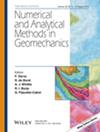Coupled Modeling of Hydromechanical Behavior of Saturated Concrete Under High Stresses and Dynamic Loading: Influence of Pore Pressure
IF 3.4
2区 工程技术
Q2 ENGINEERING, GEOLOGICAL
International Journal for Numerical and Analytical Methods in Geomechanics
Pub Date : 2025-05-07
DOI:10.1002/nag.3986
引用次数: 0
Abstract
This paper investigates the dynamic response of water‐saturated concrete under high stress levels, with a particular emphasis on the role of pore pressure. An enhanced elastoplastic damage model, incorporating dual plastic mechanisms, is proposed to capture the coupled hydromechanical behavior of concrete under combined high stress and high strain rate loading. Key improvements include the refinement of the porosity‐volumetric strain relationship, the incorporation of full hydromechanical coupling under dynamic loading, and the integration of strain rate sensitivity into the pore collapse mechanism and material strength. The improved constitutive model and numerical methodology are validated through simulations of uniaxial tensile tests and three sets of compression tests. Parametric studies are conducted to explore the influence of pore pressure on the confined response of concrete under both static and dynamic loading conditions. The results demonstrate that interstitial pore pressure significantly affects both the volumetric and deviatoric behaviors of saturated concrete, with its influence becoming more pronounced under dynamic loading. The findings provide valuable insights into the hydromechanical behavior of concrete structures subjected to extreme loading scenarios.高应力和动载作用下饱和混凝土水力学特性耦合建模:孔隙压力的影响
本文研究了高应力水平下饱和水混凝土的动态响应,特别强调了孔隙压力的作用。提出了一种包含双塑性机制的增强弹塑性损伤模型,以捕捉混凝土在高应力和高应变率联合加载下的耦合水力学行为。关键的改进包括孔隙率-体积应变关系的细化,动态加载下流体-力学耦合的整合,以及将应变率敏感性整合到孔隙坍塌机制和材料强度中。通过单轴拉伸试验和三组压缩试验,验证了改进的本构模型和数值方法。通过参数化研究,探讨静、动加载条件下孔隙压力对混凝土侧限响应的影响。结果表明:孔隙压力对饱和混凝土的体积性能和偏差性能均有显著影响,且在动荷载作用下影响更为明显。这些发现为混凝土结构在极端荷载情况下的流体力学行为提供了有价值的见解。
本文章由计算机程序翻译,如有差异,请以英文原文为准。
求助全文
约1分钟内获得全文
求助全文
来源期刊
CiteScore
6.40
自引率
12.50%
发文量
160
审稿时长
9 months
期刊介绍:
The journal welcomes manuscripts that substantially contribute to the understanding of the complex mechanical behaviour of geomaterials (soils, rocks, concrete, ice, snow, and powders), through innovative experimental techniques, and/or through the development of novel numerical or hybrid experimental/numerical modelling concepts in geomechanics. Topics of interest include instabilities and localization, interface and surface phenomena, fracture and failure, multi-physics and other time-dependent phenomena, micromechanics and multi-scale methods, and inverse analysis and stochastic methods. Papers related to energy and environmental issues are particularly welcome. The illustration of the proposed methods and techniques to engineering problems is encouraged. However, manuscripts dealing with applications of existing methods, or proposing incremental improvements to existing methods – in particular marginal extensions of existing analytical solutions or numerical methods – will not be considered for review.

 求助内容:
求助内容: 应助结果提醒方式:
应助结果提醒方式:


